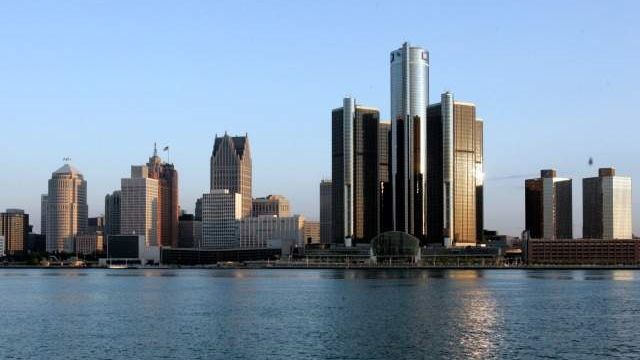Reflections on Detroit’s bankruptcy from a former Detroiter

(AP photo/Carlos Osorio, file)
My family lived in Detroit from 1955 to 1956, during which time I attended second grade in a public elementary school. That was the first year my parents moved back to Michigan from Minnesota and North Dakota, where my father did his medical specialty training. They rented a house at 15350 Birwood, just off Fenkell, also known as Five Mile Road, while looking for a home to buy near the Veterans Hospital in Dearborn where my father was employed.
My memory is of a prosperous working class neighborhood of single-family homes, occupied primarily by young families with children, lots of children. It was a safe neighborhood, where children walked themselves to school, and to visit the many stores and the movie theater on Fenkell. Except for my family it was an exclusively white neighborhood. I do not recall ever seeing a black child in my neighborhood or public school.
That characteristic of Detroit, rigid de facto racial segregation in housing and public schools, carried over into the suburbs. The reason my parents didn’t just buy and move directly into a house was that, as Chinese immigrants, they were having difficulty buying a house in Dearborn, where realtors refused to sell to them. That my father had received his U.S. citizenship as a U.S. Army medical officer during World War II didn’t make any difference. They were finally able to buy a brand new house in a new development just outside the city limits in an unincorporated area then known as Dearborn Township, which later incorporated as Dearborn Heights.
In the new neighborhood, and in the public schools I attended from third through 12th grade from 1956 to 1966, I do not recall ever seeing a black child, though I became aware of the anti-black prejudices of some of my classmates. I thought this a little strange since we had no contact in our daily lives with black people.
Like my former neighborhood in Detroit, my suburban neighborhood was mainly working-class, with a sprinkling of small business owners and professionals. Many families consisted of a father who worked in the auto factories, a mother who stayed home, and many children. In those days, a single worker with a unionized auto job could support a family and own their own house and car, and often also own a cabin somewhere in northern Michigan for vacations.
The rigid racial segregation of Detroit was unsustainable and ultimately de-stabilizing, culminating in the Detroit race riot of 1967 in which 43 persons died, 2,000 buildings were destroyed, and the city was occupied by the U.S. Army and National Guard. That event was the biggest American race riot since the New York City Draft Riot of 1863 during the Civil War, and is widely believed to have initiated the half century of decline which culminated in this week’s bankruptcy of Detroit.
A second critical factor in Detroit’s decline was the failure of Michigan’s auto industry to respond to the quality challenge of foreign competition. The business model of the Big Three automakers when I lived in Michigan seemed to be superficial annual design changes and planned obsolescence, requiring frequent trade-ins of older autos for new. New cars were shipped to dealers in paper wrappers to conceal the latest design changes until the designated new car release date.
Most Detroit families were loyal to one of the Big Three automakers. Because of its proximity to the Ford Motor Company headquarters and River Rouge factory, most families in my neighborhood, including mine, bought Ford automobiles. The first new car I could afford to buy in 1979 was a Ford.
It was a lemon, with design and other flaws that could not be fixed. I traded it in within three years for a Toyota. What a difference in quality! One bad experience with an American car, combined with one good experience with an import, was sufficient to turn millions of American families into a huge market for foreign autos, which was a disaster for Detroit.
A third critical factor in Detroit’s decline, common to many other American cities and local governments, has been leadership focused primarily on the short-term and unwilling to focus on and plan for long-term consequences. Current costs were held down in exchange for promises of generous future health care and retirement benefits for employees. Those bills eventually came due and were unsustainable.
Some of the reasons for Detroit’s demise may be specific to Detroit, but other cities and local governments have their own similar or different problems. Detroit is not the first American city to seek bankruptcy protection from its creditors, and it won’t be the last. Wherever you live, brace yourself for a bumpy ride!
WHYY is your source for fact-based, in-depth journalism and information. As a nonprofit organization, we rely on financial support from readers like you. Please give today.




